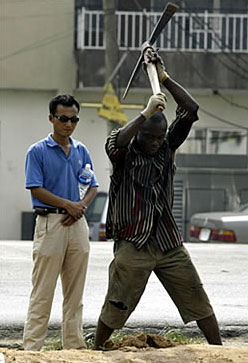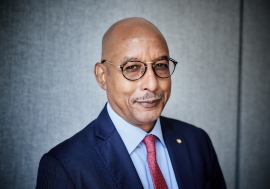Laying Africa’s roads to prosperity
Laying Africa’s roads to prosperity
 Building a highway in South Africa: The lack of more modern roads, power networks and other infrastructure hampers Africa’s economic development.
Building a highway in South Africa: The lack of more modern roads, power networks and other infrastructure hampers Africa’s economic development.From outer space the vast Cahora Bassa hydroelectric complex on the Zambezi River in Mozambique is easy to see. Originally built by the Portuguese colonial authorities and later transferred to Mozambican ownership, the dam has huge turbines that generate enough electricity to power millions of homes and businesses in South Africa and the surrounding region.
Thousands of kilometres away in rural Mali, meanwhile, a woman cuts a trench in a low earthen barrier with a practiced swing of her hoe, allowing water from the shallow pond behind it to trickle between her neat rows of millet and beans. When enough water has reached her crops she will plug the gap with a few handfuls of mud and dirt and go on about her chores.
Both the giant power station and the simple irrigation system are examples of infrastructure: the roads, ports, power, water and sanitation systems, telephone lines, radio and television transmitters and, more recently, mobile phone networks that make economic growth and development possible.
But by almost any measure, Africa lacks the infrastructure to meet the basic needs of its population and reduce poverty. Those needs are enormous. Hundreds of millions of Africans lack even the most fundamental amenities, from rural roads to basic health, education, banking and commercial services.
 A Nigerian worker digs a trench for a telecommunications cable for a Chinese company in Lagos: China is emerging as a major foreign investor in African infrastructure projects.
A Nigerian worker digs a trench for a telecommunications cable for a Chinese company in Lagos: China is emerging as a major foreign investor in African infrastructure projects.The lack of infrastructure is most severe in Africa’s long-neglected rural areas, where the majority of the continent’s 920 million people live. The burden falls most heavily on women, who often spend hours collecting wood for cooking and heating in the absence of electricity or gas. Rural women walk an average of 6 kilometres daily to rivers and springs because they lack piped water and wells. They cannot get harvests to market or take sick children to hospital because of poor roads.
Overcoming the continent’s infrastructure deficit is at the heart of Africa’s development plan, the New Partnership for Africa’s Development (NEPAD). The blueprint, adopted by African leaders in 2001, emphasizes regional planning for new infrastructure projects with the goal of allowing goods, people and information to move efficiently and freely throughout the continent.
Gaps and shortfalls
“The infrastructure gap is enormous,” African Development Bank (ADB) President Donald Kaberuka confirmed to reporters covering the UN General Assembly’s 22 September special meeting in New York on Africa’s development needs (see page 16). With African economies growing at an annual rate of 5 per cent or more, he continued, “we are all running behind,” as demands on the region’s existing infrastructure increase. “This is hampering [greater] economic growth across the continent,” he continued, referring to the fact that many economists believe African economies need to grow 7 per cent or more every year to significantly reduce poverty.
Detailed studies of the state of Africa’s infrastructure by the ADB, the World Bank and the donor countries’ Infrastructure Consortium for Africa (ICA) have found that:
- fewer than one in five people in poor African countries have electricity
- only 56 per cent drink clean water
- barely a third of rural Africans live near a road
- just 4 per cent of Africa’s farmland is irrigated
- over 60 per cent of the population lacks basic sanitation facilities.
Not only does sub-Saharan Africa’s existing infrastructure fall short of its needs, notes a detailed new World Bank study called the Africa Infrastructure Country Diagnostic (AICD), it lags well behind infrastructure development in other poor regions. Africa has only about 25 per cent of the paved road per kilometre found in other low-income regions and about an eighth of the electricity-generation capacity per person. Poor maintenance has left much of the existing infrastructure in disrepair, further hindering economic growth and discouraging new investment.
Adding ‘economic distance’
The poor state of transport and communications, Mr. Kaberuka said, adds what he described as “economic distance” to African trade. High transit costs caused by infrastructure problems make the continent’s exports less competitive on world markets and its imports more expensive for consumers.
The ICA, whose members include the Group of Eight industrialized countries, multilateral development institutions and the Development Bank of Southern Africa, estimates that poor road, rail and harbour facilities add 30–40 per cent to the cost of goods traded among African countries. The expense of moving Africa’s imports to customers inland is on average 50 per cent higher than shipping costs in other low-income regions.
Another study, by the UK government–sponsored Commission for Africa, estimated that transportation bottlenecks and inefficiencies amount to an 80 per cent export tax on Ugandan textiles, making them far less competitive on world markets, discouraging greater investment in the sector and slowing job creation. The lack of modern storage and marketing facilities is a major contributor to food insecurity, with losses to spoilage accounting for as much as 30–40 per cent of grain harvests in some countries.
The result, notes UN Secretary-General Ban Ki-moon in his report to the 22 September General Assembly meeting on Africa, is that despite the continent’s abundant natural resources, “Africa’s potential is far from being fully harnessed.”
Closing the gap
Closing the infrastructure gap is therefore vital for Africa’s future. But the price tag will be high. The Secretary-General’s report calls for more than $52 bn a year in public and private investments to close Africa’s infrastructure gap by 2010. According to the UN, donors need to provide about $38 bn per year for:
- energy — $20 bn
- transport — $11 bn
- water and sanitation — $5.7 bn
- information and communications — $1 bn.
The AICD study puts the figure higher, at about $75 bn a year, almost equally divided between the cost of new construction and of operation and maintenance. Inadequate maintenance and mismanagement of existing infrastructure, the study found, are nearly as serious a problem as the need for additional capacity. About a third of Africa’s existing infrastructure needs repair or renovation, and the percentage is even higher in rural areas and in countries recovering from war. Such deterioration is partly caused by under-funding for maintenance, the study states, “and over time represents a major waste of resources,” given the high cost of repairs compared to that of routine maintenance.
Administrative mistakes contribute to the problem, the World Bank found. African power and water companies collect only between 70 and 90 per cent of their bills. Household surveys in some countries have found that 40 per cent of customers do not pay for water and power. That figure tops 65 per cent in a few places.
Technical problems add to waste. Africa’s electric power grid, for example, loses twice as much electricity during transmission as do more modern systems, and those losses can equal 2 per cent of GDP annually. Overall, the Bank estimates, underpaid bills and waste by public utilities cost African taxpayers $6 bn annually, because it is they who must make up the shortfall.
 Source: UN Africa Renewal from ICA and World Bank data
Source: UN Africa Renewal from ICA and World Bank dataElectric power infrastructure is in particularly desperate shape. According to the World Bank, the whole of sub-Saharan Africa generates only as much electricity as Spain. This is about a tenth of the amount generated per person as in other developing regions. The AICD estimates that losses to businesses from power failures equal 5 per cent of sales every year. Losses can be four times as high in the informal economy, which employs more Africans than any line of work except agriculture.
Africa pays its way
Paying for Africa’s infrastructure needs is another challenge, although the AICD study found that current levels of investment, while insufficient, are not as low as expected. One big surprise, a World Bank researcher familiar with the AICD study told Africa Renewal in October, is the amount of money coming from Africa itself.
Local financing contributes $35 bn a year — two thirds of the roughly $50 bn being spent on African infrastructure in all. Overseas funding accounts for about $13 bn a year, with official development assistance (ODA), private investment and aid from non-traditional sources, particularly China, each accounting for about $4 bn annually.
Most African financing for new infrastructure comes from national government budgets and is concentrated in the energy, water and sanitation and transport sectors. These can be among the most expensive items in the budget, often amounting to 6–8 per cent of GDP. Operating and maintenance costs are generally financed with fees paid by users.
Among Africa’s traditional Northern donors, the AICD researcher said, “the multilateral development institutions, the World Bank, the African Development Bank and the European Commission supply a very high percentage of the ODA that is going for infrastructure in Africa — upwards of 70 per cent. The bilateral donors don’t play so large a role.”
After a long period of decline, multilateral funding for infrastructure in Africa has begun to rise, reaching $8.8 bn in 2007, a $4 bn increase from 2005 (see table). Chinese assistance, an important new source of infrastructure finance in Africa, is going mostly to energy and railway development in oil-producing countries. Private investment is almost entirely in the booming information and telecommunications industries and a few “niche” sectors like ports and container terminals.
Donor finance is far more important for countries struggling to rebuild after conflicts and natural disasters, the AICD researcher emphasized. Governments in those countries usually lack the resources to pay for reconstruction, and political instability and damaged economies make it hard to attract private investors. “They are in such a difficult situation. They have a tremendous need to rebuild and expand, yet their economies are so small. They should be prioritized for international support. It’s a huge challenge.”
Room for improvement
As important as it is to increase the comparatively low levels of infrastructure financing by outside donors and the private sector, the AICD argues, merely improving African governments’ ability to manage their infrastructure budgets would release billions of additional investment dollars. There is much room for improvement. In some countries, the study notes, more money is earmarked for specific sectors than is needed. This can lead to too much building in some areas, while pressing needs in others go unmet. Such “excess expenditure” is estimated at $8 bn a year, a fourth of what African countries spend on infrastructure.
Weak project planning and management capacity is another challenge, with some government ministries able to spend only about two thirds of their allocated infrastructure budgets in any given year. This can slow the pace of new construction and reduce the amount of money devoted to infrastructure, because unspent funds are often directed to other programmes. If ministries were able to spend their infrastructure budgets effectively and in full every year, the study estimates, an additional $3 bn would be available annually without additional burdens being imposed on African taxpayers.
The study also calls for African governments to improve their infrastructure policies and regulations to expand public access and attract wider investment. Deregulation of Africa’s telecommunications markets, for example, triggered a surge in private investment, which has fuelled the impressive growth of this sector. The AICD report also noted that government subsidies and fee structures for water and electricity tend to favour urban dwellers and the better off, restricting access to basic services by the poor and reducing incentives for expansion.
The study found that even in areas where electricity, piped water and sanitation and telephone services are available, “a significant percentage of households remain unconnected,” suggesting that hook-up charges and user fees are too high. Between 1990 and 2005, the World Bank reports, the percentage of African households connected to existing power and water utilities remained stagnant. Increasing user charges on those able to pay more and changing connection charges and subsidies to benefit the poor, the study concluded, is another way for Africa to get more from its infrastructure dollars.
NEPAD sets regional priorities
Meeting Africa’s infrastructure needs is at the heart of the African Union’s development framework, the New Partnership for Africa’s Development (NEPAD), which promotes good governance and economic policies that foster rapid and sustainable growth, poverty alleviation and better integration into the global economy. NEPAD’s $8 bn Short-Term Action Plan for infrastructure includes 20 priority projects designed to lay the foundations for an integrated African economy and attract medium- and long-term investments to close the continent’s infrastructure gap. Those priorities include:
- a West African gas pipeline to transport Nigerian natural gas to neighbouring countries to fuel electric power plants
- modernization and expansion of container-handling facilities at the strategically important Kenyan port of Mombasa
- the Nile Basin Initiative to strengthen regional cooperation and management of the river, which flows through 10 countries and is the world’s longest
- improvement of the ability of Africa’s regional economic communities to plan and manage the development of infrastructure involving more than one country.
NEPAD puts regional integration at the centre of its ambitious infrastructure blueprint. It calls for investing in regional agriculture, power, water, transport and information and communications systems. This will foster intra-African trade, create economies of scale for investment and trade, reduce high transport and communications costs and enable the free movement of people and goods across Africa’s many borders.
NEPAD’s emphasis on regional integration, said the AICD researcher, is vital if the continent is going to achieve the markets needed for efficient infrastructure development and continued economic growth. “A lot of infrastructure is only cost-effective if it is done on a large scale. When you have a lot of small countries dividing up limited resources, you produce underinvestment, inefficient and expensive services and needless duplication.”
Overcoming the huge gap between the need for electric power and what is currently available, the study contends, can only be done through regional planning. Twenty-one of sub-Saharan Africa’s 48 countries operate national power systems that are too small to be efficient. As a result, operating costs in those countries average 30 cents per kilowatt hour compared to 10 cents per hour in countries with larger power grids.
Although Africa has abundant potential for hydroelectric power, some 60 per cent of those resources are found in just two countries, the Democratic Republic of the Congo and Ethiopia. But those countries’ economies are too small to use the large amounts of power that would have to be generated to justify construction costs. Only regional power markets would be big enough to do that.
Flexibility
NEPAD’s practical, bottom-up approach to infrastructure development is another plus, the AICD analyst said, because it allows countries and regions the flexibility to set their own priorities within long-term regional plans. “One size really doesn’t fit all. One needs to see what is really driving national and regional economies and what infrastructure investments can really open up those economies.” NEPAD’s Spatial Development Programme does just that, the analyst continued, identifying existing “corridors” of economic activity, such as heavily used transport routes or productive agricultural districts, where targeted investments can deliver the greatest payoff.
With Africa’s transport networks, the AICD expert explained, it may make the most sense to focus initially on improving infrastructure in the high-traffic colonial-era corridors to the sea, rather than on building expensive new roads and power systems to expand intra-African trade.
The problem with that approach, critics reply, is that it is likely to strengthen Africa’s reliance on external trade at the expense of regional commerce and the potentially high growth rates that expanded trade within Africa could generate.
The good news, the ADB’s Mr. Kaberuka concluded at his UN press conference, is that after years of neglect and delays, “we are putting a lot of emphasis on infrastructure..... It is important for agriculture. It is important for education. It is important for health. It is important that we shorten the ‘economic distance’ in Africa.”
A difficult legacy for Africa’s infrastructure
The sad state of African infrastructure has numerous causes, including the lingering effects of colonialism. “Newly independent countries inherited, in most cases, inadequate and outward-oriented infrastructures designed largely to serve the metropole” instead of the development needs of the new states, the African Development Bank observed in a 2006 report on infrastructure financing. In the years following independence, many African governments sought to build on this meagre legacy, but their efforts were hampered by weak planning and management capacity, inadequate financing, corruption and a lack of regional cooperation.
A World Bank researcher told Africa Renewal that the infrastructure Africa inherited from the colonial days was too often oriented towards moving minerals and other raw materials to the coast for export, rather than linking African states together. But the researcher also noted that those transport corridors still carry the bulk of Africa’s commercial traffic, reflecting the low levels of trade among African countries and the subcontinent’s reliance on international markets for its imports and exports.
Colonialism’s greatest impact on African infrastructure development, the researcher continued, may have been the political fragmentation of the continent into dozens of small states. “A lot of infrastructure is only cost-effective and efficient on a large scale. When you have a lot of small countries and national boundaries involved, it can hamper investment in new construction and raise operating and maintenance costs.” Efforts to develop Africa’s numerous rivers for power generation, human consumption, farming and transportation were particularly affected by the large number of countries involved, the researcher observed, as were plans to develop regional instead of national electricity grids.
Donor-supported structural adjustment and privatization policies further set back infrastructure development during the post-independence period, says the UN Conference on Trade and Development (UNCTAD). African investment in transport infrastructure, UNCTAD notes, “has been squeezed during the past 20 years as a result of sharp cuts in public spending under structural adjustment programmes.” Although the damaging economic and social impacts of Africa’s infrastructure deficiencies were widely recognized, both African and donor investment in infrastructure dropped during the 1980s and 1990s. “This was a policy mistake,” the UK government–sponsored Commission for Africa declared in a 2005 report, and was based on the assumption that private investors would finance Africa’s infrastructure requirements.
“There was a kernel of truth in the argument that the private sector should become more involved in infrastructure development,” the World Bank expert explained. “But it was taken to a ridiculous extreme. There was a view that the private sector could take care of everything and the state and the donors could step back.” Private investment in infrastructure in Africa, the researcher continued, “happens on a spectrum, with information and communications technology at one end, and water and sanitation — with almost no private involvement — at the other.”
“Government deregulation of African telecommunications did allow the private sector to step in, tapping a new source of funding as large as development aid,” the Bank’s researcher said. “That’s all to the good. But the major needs will depend on the public sector for finance.”
















